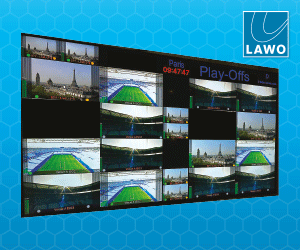The panel had a good mix of representatives from key broadcasters, manufacturers, systems integrators as well as service providers. The session began with panelists being asked about the key challenges faced by broadcasters today in an environment where technology and business models were continuously evolving. Depending on the state of each broadcaster, each had a […]
 The panel had a good mix of representatives from key broadcasters, manufacturers, systems integrators as well as service providers. The session began with panelists being asked about the key challenges faced by broadcasters today in an environment where technology and business models were continuously evolving. Depending on the state of each broadcaster, each had a different response.
The panel had a good mix of representatives from key broadcasters, manufacturers, systems integrators as well as service providers. The session began with panelists being asked about the key challenges faced by broadcasters today in an environment where technology and business models were continuously evolving. Depending on the state of each broadcaster, each had a different response.
Each broadcaster is set in a different environment and, therefore, each has a different set of issues to address. Sky News Arabia, for instance, had no legacy issues to battle with. What it required was state-of-the-art technology that rivaled systems across the world and Dominic Baillie, CTO of Sky News Arabia, seemed to suggest that products from manufacturers were just not up to the mark.
The key challenge is getting vendors to appreciate that technology has moved forward from video to IP, and content-agnostic/ format-agnostic systems in delivery.
We are trying to build systems from technology hat is old and outdated and the new technology just isnt available, he stated.
Hassan Ghoul, managing director of Grass Valley agreed that manufacturers need to stay ahead of the game.
The challenge for a manufacturer is to anticipate what the next requirement of the broadcaster is and try to empower them with the tools and facilities to go forward with their plans. It is important for manufacturers to look into all the processes that the file-based workflows introduce, and anticipate how these processes are going to evolve in the new era, he added.
For MBC and DMI that are dealing with legacy systems and attempting to migrate to a tapeless workflow, often the scale of migration and the volume of change can be mind boggling not just for the heads but also for staff.
Group Technical Director Andy Palmer says his biggest challenge has been disengaging people from the idea that they have to carry a tape and encouraging them to trust their content to a computer.
For Afzal Lakdawala, who heads the technology planning and projects department at Dubai Media Inc, commented that moving away from legacy systems is a Herculean task as the state broadcaster is so massive.
We have an aggressive three-year plan to move to a tapeless file-based workflow, which also supports the shift to HD broadcasting. These plans cannot be achieved overnight. We have recently revamped DMIs news centre to a completely file-based operation end-to-end, and broadcast the Olympics in a completely tapeless environment but there are so many different chunks left to deal with, he stated.
Pay TV network, which has just launched OSN Play for different platforms, has a different set of issues. Unlike state broadcasters, its biggest mandate is increasing its subscriber base and it has left no stone unturned to make this happen.
Frank Kerrin says the delivery to additional screens, for instance, was primarily intended to retain existing subscribers although it will hopefully generate additional revenue in the future.
He added that OSN plans to increase its HD channels portfolio.
Our plan is to have the entire OSN platform in HD-only by 2014.
Speaking on behalf of the systems integrators (SI), was Steve Halis, CTO of Salam Media Cast. He stated that an SI needs to respond quickly to the evolving requirements of clients and build future-proof systems.
He stated that every client has their own issues, challenges and business models. While some seem content to invest in the newest technologies and deliver content across various platforms with no thought about revenue, others have revenue as their top priority.
We have a wide gamut of technologies and choices that we can now put in front of our clients. We are chasing new media wherever it is, and need to deliver to the platform that people choose.
Grass Valleys Ghoul also pointed out that as most of the multi-screen content is now repurposed from linear content, one should look at the processes from the start to the finish to have a complete integrated workflow.
David Sallak of Isilon pointed out that in a very complex world, where we have almost 100 deliverable formats, there is a dire need for simpler infrastructure.
Traditional linear broadcasts still constitute the main revenue generating source for broadcasters, but the new delivery platforms create opportunities. The manufacturers can play a role in helping broadcasters deliver to different places, to the complexity of the new platforms, but do it in a simple way, he stated.
Sallak explained that this can be achieved by leveraging the infrastructure and making the delivery simpler, and doing it in an open way.
The broadcasters are asking manufacturers to support the flexibility so they can be more efficient. When broadcasters have to deliver to 100 linear and non-linear formats, flexibility becomes key.
Omran Abdallah, Engineering Director at twofour54, called for broadcasters to sit together and agree on certain standards.
New challenges include working with a number of formats and the extra costs associated with adding plugins to various systems such as post-production or archiving [so all these systems can talk to each other], he pointed out.
The discussion led the panelists to question if sticking to one house format at the highest possible quality from which various versions could be created for delivery to multiple screens would be the way forward.
MBCs Palmer said there was a need for more flexible systems that would enable broadcasters to easily change their workflows as and when business requirements dictated this change without having to revert to vendors.
Sallak added that big data can be beneficial to the broadcasting industry. By applying analytics and face recognition tools to a broadcasters archive, for example, he explained that there could be greater wins and added value to the stored content that is usually saved in deep archives but often wasted and never used again.
Cloud computing was debated with varying opinions from the panelists. The issue of security was raised and whether content owners would be comfortable in storing their valuable content in an environment outside their control. The cost of connectivity in the region was identified as a barrier against adoption of cloud services. What services could be accepted to be cloud-based, such as content repurposing or deep archiving, was also discussed.
– Moderator Hasan Sayed Hasan, Managing Director of Master Media, summed up this panel discussion.
















































































